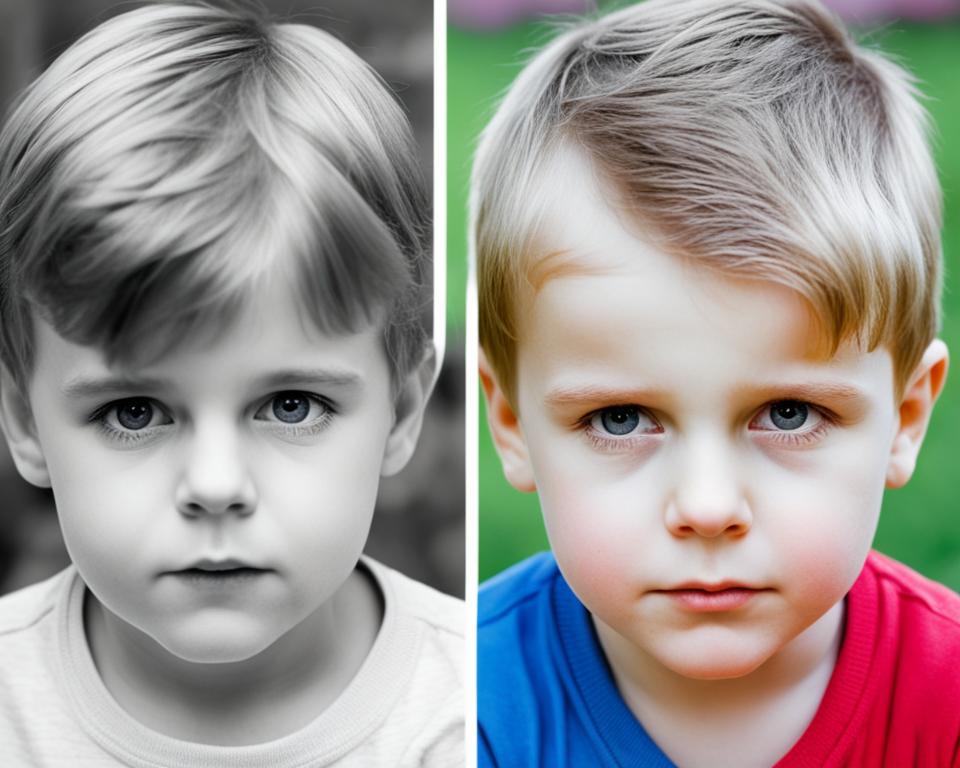Understanding how to communicate with a nonverbal autistic child is a challenge many parents, caregivers,…

Shy Child vs. Autism: Spotting the Difference
Within the complex tapestry of child behavior, parents and caregivers often find themselves pondering the nuances between a shy child and signs of autism spectrum disorder. It’s a common crossroad where early intervention becomes a beacon of hope for guiding developmental disorders along a path of enrichment rather than uncertainty. This sensitive differentiation calls for a keen observation of a child’s social interaction, communicative cues, and their unique way of traversing the world around them.
The silence of a child may speak in different dialects: the pause before a hesitant step into a playground filled with peers, or the lack of words when emotional waves run too deep. A shy child may dabble in solitude yet finds a hidden gate to social communication, eventually merging their narrative with others. Autism – a more complex partner in this dance – can rewrite social interaction scripts in a distinctive language that, too often, calls for a translator in the form of tailored support and understanding.
Decoding this intricate world is vital, as every discovery solidifies the bridge between early signs and effective response. The journey of unlocking these secrets is not solitary; it is a collective effort that aligns professional expertise with the unique rhythm of each child. As we embark on this exploration, the interplay of behavior paves the way for individual growth and connection, ensuring no child’s potential is left unspoken.
Deciphering Child Behaviors: Shyness and Autism
Understanding the nuances of children’s behavior can be intricate, especially when discerning between natural shyness and autism spectrum disorder. Recognizing how a child interacts in social settings, responds to sensory experiences, and exhibits consistent behavioral patterns can provide valuable insights into their development.
Observing Social Interaction and Engagement
Initiating and maintaining social interaction can pose challenges for both shy children and those on the autism spectrum. The key differentiation lies in the child’s progression over time. A shy child, often dealing with social anxiety, may display reserved behavior initially yet show gradual improvements in engagement and eye contact when interacting with peers and adults in familiar contexts. Conversely, a child with autism may persistently avoid social interaction, demonstrating a lack of interest in communal play or shared activities, which can complement a speech delay and stand as a marker for autism.
Understanding Response to Sensory Inputs
For a child exhibiting signs of sensory overload, everyday textures, sounds, or lights might prove overwhelming. A shy child might flinch at loud noises but generally can regain composure swiftly. On the other hand, children with autism spectrum disorder may experience heightened distress and may show more intense reactions to sensory stimuli, which may not abate with ease. This response can disrupt achieving developmental milestones and must be monitored closely by caregivers and professionals.
Identifying Consistency in Behavioral Patterns
Consistency in behavior serves as a distinguishing factor when comparing shyness with autism. While a naturally shy child typically adjusts over time, a child on the autism spectrum can exhibit repetitive behaviors or a keen fixation on certain objects or routines, indicating a preference for predictability and certain repetitive motor patterns, which may not be significantly present in children simply experiencing shyness.
- Observe the child in varied social scenarios to assess their adaptation skills.
- Monitor sensory reactions to differentiate between a shy child and one facing sensory overload issues.
- Watch for repeated patterns that may signal more than shyness, such as a lack of responsiveness to name calling or an inclination towards sameness.
Analyzing Communication: Delving into Developmental Nuances
Differentiating between shy children and those with an autism spectrum disorder (ASD) often hinges on understanding and assessing their distinct communication styles. Recognizing the signs of autism is crucial, as it can lead to earlier intervention and support for children with this developmental disorder.
Children with ASD may exhibit a range of communication challenges, from speech delay to difficulties with nonverbal communication. These developmental concerns require a nuanced approach to both identify and understand. Conversational skills, or the lack thereof, can be particularly revealing in how a child with autism relates to others and navigates social communication.
- Verbal Language: A hallmark of autism spectrum disorder, observable communication issues such as limited speech, echolalia, or unusual language patterns are key indicators.
- Nonverbal Communication: Nonverbal cues are often as vital as spoken words. Observing a child’s use of gestures and body language provides insights into potential difficulties with nonverbal communication skills.
- Conversational Pragmatics: This involves the social use of language, like taking turns when talking and fitting into the flow of dialogue areas where children on the spectrum might struggle.
- Emotional Expression: An important aspect of social communication, children with ASD may have trouble both expressing their own emotions and understanding others’ emotional cues.
When gauging child behavior, it’s also critical to look at how children engage in social interaction. Do they make small talk? How do they react to others speaking to them? Do they follow a conversation or change the topic unexpectedly?
- Monitor the child’s ability to make and maintain eye contact during discussions.
- Assess the child’s response or lack of response to their name being called, as delayed reactions can signify a communication issue.
- Notice patterns of speech, such as repetitive use of phrases or a preference for specific topics, which may point towards developmental disorders like autism.
Each of these factors verbal and nonverbal communication capabilities as well as conversational skills plays a critical role in social interaction. By closely observing these, one can discern whether a child is simply shy or if there is an underlying developmental issue that requires attention.

Shy Child vs. Autism: Analyzing the Subtle Distinctions
Identifying whether a child is simply shy or on the autism spectrum requires keen observation and understanding of nuanced behaviors. While both shy children and those with autism display a reserved nature, distinctions in their behavior offer valuable insight. It’s crucial to approach this with sensitivity to avoid misinterpretation and to ensure that children receive appropriate guidance and support, whether they require assistance overcoming social anxiety or need early intervention services for a developmental disorder.
Evaluating Social Relationships and Adaptability
Understanding a child’s adaptability in social relationships can illuminate their unique challenges and needs. A shy child typically develops a bond with trusted individuals and exhibits some degree of adaptability after initial hesitation. Conversely, a child with autism may persistently favor playing alone and struggle with adapting to social changes. Observing their interactions, such as reluctance or indifference to seek comfort from a parent or their reaction to peer engagement, is crucial. These behaviors are important indicators when considering the broader context of social interaction and potential developmental concerns.
Recognizing Emotional Reaction and Comfort Levels
Emotional responses and comfort levels provide another layer of differentiation. A child grappling with shyness may initially appear reticent but still portrays an emotional response that aligns with the situation. Children with autism spectrum disorder, however, may demonstrate a more limited range of emotional expressions, and often, their body language does not accurately reflect their comfort levels or understanding of others’ feelings. Regularly observing and understanding these emotional cues can be an essential part of recognizing the child’s experiences and aligning them with either shyness or a symptom of autism.
Assessing Changes in Behavioral Milestones
Monitoring the progression or regression of behavioral milestones is fundamental. Any noticeable step back in a child’s communicative abilities, social skills, or other developmental markers should raise concerns. Quick action in such instances can ensure the child receives necessary assessments to understand whether this signifies a variant of shyness or if it’s indicative of autism. Early detection is invaluable, granting access to a range of resources and supportive measures that help foster their potential and growth, thus underscoring the pivotal role that observant caregivers play in their development.
FAQs
How can I tell if my child is simply shy or may be on the autism spectrum?
It’s important to look at your child’s social interactions, their response to sensory inputs, and behavioral patterns. While both shy children and those with autism might be reserved, children with autism often have greater challenges in communication, may not respond to their name, struggle with back-and-forth conversation, and may not understand social cues or emotions. Shy children usually comprehend social cues and can adapt to new settings over time.
What are some key things to observe in social interaction that might indicate autism rather than shyness?
Observe if the child makes eye contact, responds to social cues, and shows a ‘warming up’ behavior in social settings. Autistic children might not exhibit these behaviors and often show less interest in interacting with others, preferring solitary activities.
Can a child’s response to sensory input help differentiate between shyness and autism?
Yes, children on the autism spectrum may have heightened responses to sensory stimuli, such as being easily overwhelmed by loud noises or certain textures, which is not typically seen in shy children. Observing how a child reacts to sensory experiences can offer clues about potential sensory overload issues associated with autism.
Are there specific behavioral patterns that suggest a child might have autism?
Look for consistent and repetitive behaviors, difficulties in adjusting to changes in routine, and any challenges in playing or interacting with peers. Unlike shy children, who may simply prefer less interaction, autistic children often show restricted interests and repetitive actions or speech.
How does understanding social communication help in identifying autism?
Difficulty with verbal language, understanding nonverbal cues, and engaging in conversations are signs of autism spectrum disorder. If a child struggles with these aspects of communication, it’s worth evaluating them for potential developmental disorders.
What should I watch for in evaluating my child’s social relationships and adaptability?
Assess if your child seeks reassurance from you in social situations, shows comfort with familiar people and environments, and can adapt to new social settings after some time. Children with autism often do not seek comfort from others and may consistently prefer to play alone.
How do emotional reactions help distinguish between a shy child and one with autism?
Though shy children might be hesitant or uncomfortable, they usually still express a range of emotions and can read others’ feelings. Children with autism, however, may have a limited expression of emotions and often find it difficult to interpret others’ emotional responses.
Why is it important to assess changes in behavioral milestones?
Monitoring your child’s developmental milestones can help identify any regressions or delays in language, social skills, or other developmental areas. Early identification of these issues is crucial for timely intervention, which can greatly benefit children with autism spectrum disorder.



This Post Has 0 Comments